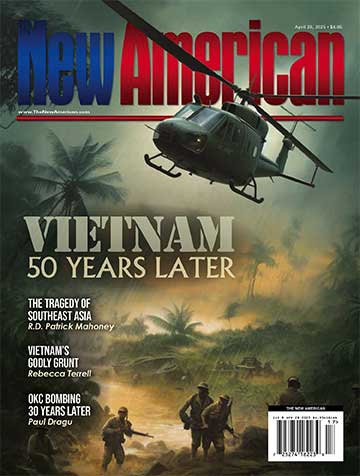
As President Trump is pressured to ban “assault rifles,” he should note that no such weapons have been used in any mass shooting in memory. In the reporting on these events, however, assault commentary is regularly deployed.
Trump could also note, as he prepares to visit the sites of two weekend mass shootings and is criticized for telling the truth about illegal migration, that illegal aliens have killed far more American citizens than “assault rifles” have.
You wouldn’t know this reading the mainstream media. A good example is Reuters, which writes that the president “dismissed legislation to ban assault rifles as politically unfeasible on Wednesday as he prepared to visit” El Paso and Dayton, where the two shootings occurred.
The fake news is right in Reuters’ first sentence. In reality, “assault rifles” had always referred to either fully automatic weapons (i.e., machine guns) or those having a selective-fire feature, allowing them to be fired semi-automatically or fully automatically (and sometimes also in three-shot bursts). And such weapons have long essentially been banned — since the enactment of the National Firearms Act of 1934.
Why does this matter? Because if we want to prescribe a problem’s cure, we first have to make the correct diagnosis, a prerequisite for which is assembling the facts of the case.
One fact is that I wrote “essentially” above because legally owning a machine gun is possible, but very difficult, requiring the acquisition of a federal machine-gun license and a significant monetary investment. This is why, of the approximately 393 million civilian-owned legal firearms in the United States, only about 250,000 are machine guns (generally in the hands of firearm aficionados).
Another fact is that, again, no machine gun (or “assault weapon”) has been used in any mass shooting in memory. In fact, according to GunCite.com, we know of only two homicides committed with legally owned machine guns since 1934. Moreover, one of those was committed in 1988 by a police officer — someone who would’ve had access to an automatic weapon regardless of the laws in place — in, coincidentally, Dayton, Ohio.
In reality, mass shootings have generally been perpetrated with semi-automatic weapons (the exceptions would be manually operated shotguns). These firearms’ function is exactly what laymen would assume a gun’s would be: Every time the trigger is pulled, one bullet is released.
So why do we hear so much about “assault weapons”? In part, it’s because in recent decades the government has engaged in bureaucratic sleight of hand, categorizing firearms as assault weapons not based on function, but on cosmetic features. For example, a .223-caliber rifle without a pistol grip may not be thus categorized; put such a grip on, however, and “Voila!” It magically becomes one even though its caliber, power, and rapidity of fire remain the same.
This is silly, of course. You might as well put a Porsche body on a Yugo chassis and expect to go 0 to 60 in 4.5 seconds.
The media are also complicit in the deception. Not only are reporters generally ignorant about firearms and thus often oblivious to the above facts, but the term “assault rifle” is great for marketing gun control; it sounds like something scary that absolutely must be taken off the street.
In reality, though, even the firearms incorrectly labeled assault weapons — such as the AR-15 — are used in only “about one-fifth of one percent (.20 percent) of all violent crimes and about one percent [of] gun crimes,” writes GunCite.
This, however, is something some media types do know. Just consider what the Washington Post wrote in 1994 about the “assault-weapons” ban. “No one should have any illusions about what was accomplished,” the paper conceded. “Assault weapons play a part in only a small percentage of crime. The provision is mainly symbolic; its virtue will be if it turns out to be, as hoped, a stepping stone to broader gun control.”
Many gun grabbers also know what’s required to create such misguided bans: misinformation. As Violence Policy Center founder Josh Sugarmann once noted, “Assault weapons’ menacing looks, coupled with the public’s confusion over fully-automatic machine guns versus semi-automatic assault weapons — anything that looks like a machine gun is assumed to be a machine gun — can only increase the chance of public support for restrictions on these weapons.”
Of course, the media feed these misconceptions, and this brings us to what’s truly dangerous: assault commentary. Those guilty of it know that words are powerful, that, as the saying goes, the “pen is mightier than the sword”; they prove this every time they claim that President Trump is inciting violence with “irresponsible rhetoric.” Yet they’re engaging in projection.
How much hatred, fear, anger, and unrest are fomented when the media accuse Trump of being a Nazi and a fascist, and of running concentration camps and locking children in cages?
Reuters tells us that when the president left the White House, he “said he wanted to strengthen background checks for gun purchases and make sure mentally ill people did not carry guns.” Is there anything, though, that we can do to make sure mentally ill people don’t carry pens or keyboards?
Is this hyperbolic? How else do you describe people who, as NBC News’ Paul Reyes and MSNBC anchor Nicolle Wallace just did, say on TV that Trump wants to “exterminate Latinos”? What about former FBI official Frank Figliuzzi, who said on MSNBC that Trump’s decision to fly American flags at half mast until 8/8 to honor the weekend’s shooting victims is a secret “Heil Hitler!” signal?
Reuters also says that Trump faces an uncertain welcome when he visits Texas and Ohio. But all of us face an uncertain future, and both uncertainties are caused by the media, whose exercise of their First Amendment rights is as irresponsible as the El Paso and Dayton shooters’ exercise of their Second Amendment rights.
Assault commentary kills.
Photo: TheAlphaWolf via Wikimedia




